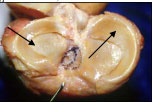Articular Cartilage Injury
Cartilage in general is a tissue that is designed to absorb loads and has an almost gelatinous consistency. There are two types of cartilage that commonly get injured.
The surface of the ends of the bones that serves as gliding surface and shock absorber during activities of daily living is made up of cartilage. This cartilage is called "articular cartilage" (see below).

Another type of cartilage in the knee joint acts as an additional shock absorber and helps to stabilize the knee joint during motion. This cartilage is called "meniscal cartilage" (see below).

The function of both types of cartilage is to provide low amounts of friction within the joint as well as providing shock absorption during weight bearing activities. These activities include walking or jogging, climbing stairs, and work or sports related activities. After a knee injury, one or both of these types of cartilage can be injured.
Signs of a cartilage injury
Signs of cartilage injury are often very subtle. They include:
- Pain and swelling
- Locking or catching
- Stiffness and decrease range of motion
- Popping or cracking sounds or sensations
Causes of a cartilage injury
In general, cartilage can tear just from wear and tear. This is usually the beginning of osteoarthritis and is due to mechanical degeneration. Another reason for a cartilage tear can be an acute traumatic event such as a fall, a sudden twist or a direct hit.
In children and adolescents, a condition known as osteochondritis dissecans (OCD) can cause cartilage to die. This can be the reason for small or large cartilage defects. Fortunately most of these defects can heal without the need for surgery.
Treatment options
If you have a meniscal cartilage injury, your doctor has several options available to treat this problem. These options include:
- Physical therapy
- Anti-inflammatory medication
- Injections
- Arthroscopic surgery
It is up to you and your doctor to decide which one of these options is most appropriate for you.
If you have an articular cartilage injury, your doctor may initially treat you similarly. However, often it becomes necessary to do an arthroscopic surgery to directly look at the articular cartilage defect. Only after this direct evaluation of the defect will your orthopaedic surgeon be able to assess the true extent of cartilage damage. This assessment in conjunction with many other factors such as previous injuries to the joint, joint instability or alignment of your entire extremity (i.e "knock knees", "bowed legs") will determine what treatment options you and your surgeon have available.
